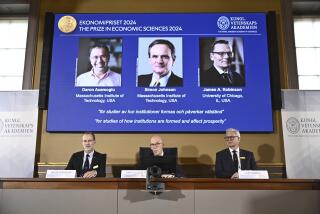Scientific research increasingly fueled by prize money

- Share via
Back when he was in medical school in the 1970s, Gary Michelson was nauseated by the portion of his training known as dog lab — a class where surgeons-in-training removed dogs’ organs one at a time, over 13 weeks, with no post-operative pain relief, until their animal “patients” could no longer survive.
The lab bothered Michelson so much, he openly defied the dean’s orders to do the operations. “I said, I don’t understand that I need to mutilate a dog to learn how to be a competent surgeon for human beings,” he said.
These days, the Los Angeles spinal surgeon and inventor would still like to save animals’ lives, but through a new cause: birth control for dogs and cats.
Michelson has the means: He received a $1.35-billion settlement in 2005 related to his spinal surgery inventions. He wants to use some of that to put an end to millions of euthanasias by getting scientists to invent an inexpensive, single-dose method for sterilizing dogs and cats.
Biotech companies haven’t been interested in producing the Pill for a pit bull or an IUD for a Siamese, because it wasn’t likely to be very profitable. Top-notch scientists didn’t have much motivation to figure out if it was even possible.
Michelson hopes to make it worth their while with the Michelson Prize in Reproductive Biology — a cool $25-million purse for the first researcher to solve the problem.
Ever since the splashy success of the Ansari X Prize, which in 2004 awarded $10 million to a team that launched a spacecraft 60 miles above Earth, funders are turning to contests — some with big cash prizes — to get answers to nagging scientific questions.
Taking their cue from the potentates of old, who often pitched competitions to spur creative minds, prize sponsors today say that offering incentives gets new people thinking about old problems.
Bottom-line-oriented philanthropists only pay for successes — and their payoffs can be large. (The Found Animals Foundation, for example, will own the rights to the winning sterilization technology, though Michelson has said he wants a “high-volume, low-profit model” and that he will “try to give this away.”)
The X Prize Foundation, based in Los Angeles, is running multimillion-dollar contests to sequence genomes, send robots to the moon and create health-monitoring sensors.
Others chase humanity’s classic quests — human-powered flight, or eternal life.
For more than 30 years, the American Helicopter Society International has operated the Sikorsky Prize, which initially set out to pay $20,000 to the first team to design and fly a human-powered helicopter for at least a minute at a height of about 10 feet. (Sort of like Icarus’ wings of wax, the attempts haven’t really worked; a 2009 pledge from the Sikorsky Aircraft Corp. upped the prize to $250,000.) Anti-aging guru Aubrey de Gray’s Methuselah Foundation has offered millions for prolonging life in laboratory mice.
In all, researchers at McKinsey and Co. estimated in 2009, the value of contest rewards larger than $100,000 had tripled over the preceding decade, to $375 million.
Even the federal government is dipping a toe in the water.
In January 2011, President Obama signed the America Competes Act, which made it legal for any federal department or agency to offer prizes up to $50 million.
Today, more than 45 government agencies have placed more than 225 prizes into play, according the White House Office of Science and Technology Policy. NASA, which has pursued contests for years, has asked for ways to map dark matter in space; for better gloves for astronauts; and for components to build an elevator to space. The National Institutes of Health is awarding $100,000 for ideas for eye research.
Previously, “they had to almost know you’d be successful before they’d give you funding. Prizes turn that on its head,” said Erika Wagner, former executive director of the X Prize Lab @ MIT, one outpost in the cottage industry that has sprung up around the competitions.
Wagner doesn’t expect contests to wipe out the old ways of paying for science — after all, the vast majority of the approximately $140 billion the federal government set aside for research in 2012 is distributed through tried-and-true means, including grants. But she does think contests can bring outsiders, and new approaches, to the table.
“Prizes tend to be won by people on the outside of a field,” she said. “Many of these ‘crazy’ ideas are off-target, but all you need is one brilliant one.”
::
In some ways, the prize resurgence is a step backward, to a time when the whims of royalty steered the course of science.
For centuries, breakthroughs hinged on cash awards, said Jaison Morgan, a former head of prize development for the X Prize Foundation who now helps craft competitions as chief executive of Santa Monica-based Common Pool.
“Things were slowed down by the secrecy of merchant guilds,” he said. “To solve a problem quickly, the king put up a prize.”
A 2008 report from the consulting group Knowledge Ecology International cataloged dozens of examples.
Napoleon Bonaparte created a 12,000-franc prize for the preservation of food, in part so he could feed his troops as they marched across the more barren, or hostile, corners of Europe. That prize — the salary of a high-ranking public official at the time, according to UCLA historian Lynn Hunt — was awarded in 1809 to Nicolas Francois Appert, who preserved boiled food in champagne bottles, inventing commercial canning.
The emperor’s nephew Napoleon III launched an 1869 competition to produce a butter substitute, giving the world margarine. The famous Longitude Prizes offered by the Spanish, Dutch and British eventually gave explorers a way to navigate the high seas. The 1919 Orteig Prize for the first nonstop flight between New York and Paris went to Charles Lindbergh in 1927 and spawned an aviation boom.
But the landscape changed after World War II, Morgan said, as governments began funding large-scale science and intellectual property laws offered companies incentives to look for new technologies on their own.
“Market power takes over the story,” he said, “and prizes fall off the face of the Earth.”
Many trace the current prize boom to the success of the Ansari X Prize, but there are other reasons for the resurgence.
The sluggish economy is a factor. “When there’s not as much university and NIH funding, more people are willing to work with us than would have been willing to years ago,” said Aimee Gilbreath, executive director of Michelson’s Found Animals Foundation.
Further feeding interest is the Internet, which provides a cheap way for a variety of people to hear about, participate and collaborate in the contests.
David Kirkby, a professor of physics and astronomy at UC Irvine, heard about NASA’s Mapping Dark Matter challenge from a blog published by Wired. He and a grad student won a token prize — an all-expenses-paid trip to Caltech, a 45-minute drive from his office — for writing a computer program that could accurately measure the shape of 100,000 simulated galaxies. The contest was administered by the prize contest website Kaggle.
Before the contest, Kirkby had been looking for a way to expand his research beyond particle physics. The contest gave him a way to break into a new field. And he wasn’t the only newcomer to take part: Another high-performing contender was a glaciology student from the University of Cambridge in England.
“If you’re asking a question where the solution is a piece of software, anyone with a laptop and the time can enter,” Kirkby said. “You get people of all kinds of backgrounds and levels of seniority working together. You get collaborations.”
But Kirkby, and others, have worried that letting wealthy enthusiasts so closely guide science could distort priorities. If everything is a goal-based contest, what becomes of basic research? Who’ll look into the causes that don’t have flush supporters?
“As a country, we want the best people working on the most important problems, not the problems being sold at the highest price,” he said.
Michelson’s contest represents a sort of middle ground. He is providing the researchers competing for his prize with grants of up to $250,000 a year, totaling up to $50 million. That should leave plenty of room for the scientists to make strides in fundamental research.
Twenty-two teams of researchers are working on the sterilization problem already, silencing genes and stimulating immune systems to try to shut down the reproductive cycle.
At an April meeting of the grantees in Santa Monica, many seemed invigorated by the competition.
Seated around a rectangle of tables, with Michelson perched at the head, they talked through their research and fielded pointed questions from their competitors. Occasionally a scientist would climb out of his seat to get a better view of a graph or a photo.
During a midmorning coffee break, biochemist Tatiana Samoylova said she was enjoying the back-and-forth.
Usually, she said, she didn’t get that kind of quick feedback from funders and other researchers. And the focus on a solution appealed to her.
“Most of us dream of that,” she said. “You don’t want to be a building block.”







